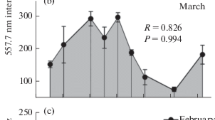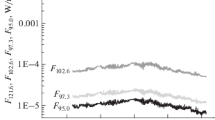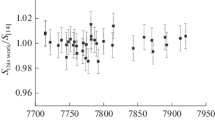Abstract
Based on the measurements of 656.3-nm emission of atomic hydrogen, we constructed a model of variations in its intensity, which describes the dependence of diurnal, lunar, seasonal, latitudinal, and long-term variations, during the 11-year cycle of solar activity, cyclic aperiodic variations, and variations after geomagnetic disturbances.
Similar content being viewed by others
References
T. M. Donahue, “Hα Excitation in the Hydrogen near the Earth,” Planet. Space Sci. 12(2), 149–159 (1964).
Kh. M. Fadel’, A. I. Semenov, N. N. Shefov, et al., “Quasibiennial Variations in the Temperatures of the Mesopause and Lower Thermosphere and Solar Activity,” Geomagn. Aeron. 42(2), 203–207 (2002) [Geomagn. Aeron. 42, 191–195 (2002)].
L. M. Fishkova and G. V. Markova, “On the Hα Line in the Nightglow Spectrum,” Astron. Tsirk. AN SSSR, No. 196, 8–9 (1958).
L. M. Fishkova and N. M. Martsvaladze, “On the Behavior of the HI 656.3 nm and [OI] 630 nm Emissions of the Upper Atmosphere during Magnetic Storms with Sudden Commencement,” Geomagn. Aeron. 25(3), 509–511 (1985).
L. M. Fishkova and P. V. Shcheglov, “Daily Variations in the Nightglow Hα Emission Intensity,” Byull. Abastuman. Astrofiz. Obs., No. 42, 29–36 (1972).
L. M. Fishkova, “Variations in the Intensity and the Spatial Distribution of the Nightglow 6563 — HI Emission,” Byull. Abastuman. Astrofiz. Obs, No. 29, 77–91 (1962).
L. M. Fishkova, “Studying Hydrogen of the Upper Atmosphere and Geocorona Based on the Observations of the Hα Emission Line in the Nightglow Spectrum,” Byull. Abastuman. Astrofiz. Obs., No. 42, 131–181 (1972).
L. M. Fishkova, Nighttime Emission of the Earth’s Midlatitude Upper Atmosphere, Ed. by N. N. Shefov (Metsniereba, Tbilisi, 1983) [in Russian].
L. M. Fishkova, “On the Spatial Distribution and Variations in the Nightglow Hα Emission,” Polyarn. Siyaniya Svechenie Nochnogo Neba, No. 10, 35–39 (1963).
R. L. Gattinger and Jones A. Vallance, Physics and Chemistry of Upper Atmospheres, Ed. by B. M. McCormac (Reidel, Dordrecht, 1973), pp. 184–192.
A. Gill, Dynamics of the Atmosphere and Ocean, Vols. 1, 2 (Mir, Moscow, 1986).
V. S. Goryacheva, “Zvenigorod Geophysical Observatory: Brief Results of Studying the Intrinsic Emission of the Upper Atmosphere,” Polyarn. Siyaniya Svechenie Nochnogo Neba, No. 22, 5–18 (1975).
Handbook of Mathematical Functions, Ed. by M. Abramowitz and I. A. Stegun (Dover, New York, 1965; Nauka, Moscow, 1979).
R. B. Kerr, R. Garcia, X. He, et al., “Periodic Variations of Geocoronal Balmer-Alpha Brightness Due to Solar-Driven Exospheric Abundance Variations,” J. Geophys. Res. 106A, 28 797–28 817 (2001a).
R. B. Kerr, R. Garcia, X. He, et al., “Secular Variability of the Geocoronal Balmer-Alpha Brightness: Magnetic Activity and Possible Human Influences,” J. Geophys. Res. 106A, 28 819–28 829 (2001b).
E. V. Kononovich and N. N. Shefov, “Fine Structure of the 11-Year Cycles of Solar Activity,” Geomagn. Aeron. 43(2), 166–173 (2003) [Geomagn. Aeron. 43, 156–163 (2003)].
V. I. Krassovsky, “Atmospheric Emission of Hα Atomic Hydrogen according to the Observations in Zvenigorod, Abastumani, and Alma-Ata,” Geomagn. Aeron. 9(3), 418–429 (1971).
V. I. Krassovsky and Y. I. Galperin, “Review of Observational Results on the Airglow and Aurorae,” Trans. Int. Astron. Union 10A, 327–328 (1960).
V. I. Krassovsky, “Energy Sources of the Upper Atmosphere,” Planet. Space Sci. 1(1), 14–19 (1959).
V. I. Krassovsky, N. N. Shefov, and O. L. Vaisberg, “Atomic Hydrogen and Helium in Airglow,” Ann. Geophys. 22(2), 208–216 (1966).
N. M. Martsvaladze and L. M. Fishkova, “On One of the Possible Causes of Irregular Variations in the Hydrogen Emission of the Upper Atmosphere,” Kosm. Issled. 20(5), 773–775 (1982).
N. M. Martsvaladze, “The Effect of Lunar Tides on the Hα Emission of the Upper Atmosphere,” Byull. Abastuman. Astrofiz. Obs., No. 45, 87–90 (1973).
N. M. Martsvaladze, “Spatial Distribution of the H Emission in the Earth’s Upper Atmosphere, Its Variations during the Solar Cycle, and the Dependence on Geomagnetic Disturbances,” Byull. Abastuman. Astrofiz. Obs., No. 42, 39–45 (1972).
N. M. Martsvaladze, L. M. Fishkova, and N. N. Shefov, “Disturbed Variations in the Hydrogen Emission,” Astron. Tsirk. AN SSSR, No. 619, 5–6 (1971).
H. G. Mayr and H. Volland, “Composition Waves in the Thermosphere,” J. Geophys. Res. 18(4), 671–676 (1976).
R. R. Meier, “Balmer Alpha and Balmer Beta in the Hydrogen Geocorona,” J. Geophys. Res. 74(14), 3561–3574 (1969).
R. R. Meier, D. E. Anderson, L. J. Paxton, and R. P. McCoy, “The OI 3d 3 D 0-2p 4 3 P Transition at 1026 Å in the Day Airglow,” J. Geophys. Res. 92A, 8767–8773 (1987).
R. R. Meier, G. R. Carruther, T. L. Page, and A. C. Lavasseur-Regourd, “Geocoronal Lyman and Balmer Emissions Measured during the Apollo 16 Mission,” J. Geophys. Res. 82(4), 737–739 (1977).
A. S. Monin, “Inertial Motions on a Rotating Sphere,” Izv. Akad. Nauk SSSR, Fiz. Atmos. Okeana 8(10), 1035–1041 (1972).
A. S. Monin, Theoretical Backgrounds of the Geophysical Hydrodynamics (Gidrometeoizdat, Leningrad, 1988) [in Russian].
G. A. Nasyrov, “Effect of Geomagnetic Activity on Atomic Oxygen Emissions,” Geomagn. Aeron. 10(6), 1112–1114 (1970).
M. Nicolet, “Aeronomic Chemistry of Ozone,” Planet. Space Sci. 37(12), 1621–1652 (1989).
V. S. Prokudina, “On the Observation of the λ 6562 Å Line in the Nighttime Sky Spectrum,” in Spectral, Electrophotometric, and Radar Studies of Auroras and Nightglow, Ed. by V. I. Krassovsky (Akad. Nauk SSSR, Moscow, 1959) [in Russian].
Z. Ts. Rapoport and N. N. Shefov, “Relation between Variations of Hydroxyl Emission and Radio Wave Absorption in D-Region,” Indian. J. Radio Space Phys. 3(3), 314–316 (1974).
H. Rishbeth, “Transequatorial Diffusion in the Topside Ionosphere,” Planet. Space Sci. 15(8), 1261–1265 (1967).
F. E. Roach and J. L. Gordon, The Light of the Night Sky (Reidel, Dordrecht, 1973; Mir, Moscow, 1977).
A. I. Semenov and O. T. Yurchenko, “Hydrogen Dissipation and Temperature of the Earth’s Thermosphere,” Astron. Vestn. 20(1), 15–19 (1986).
A. I. Semenov, “Long-Term Changes in the Height Profiles of Ozone and Atomic Oxygen in the Lower Thermosphere,” Geomagn. Aeron. 37(3), 132–142 (1997) [Geomagn. Aeron. 37 (3), 354–360 (1997)].
P. V. Shcheglov, “On the Concentration of the Nightglow Emission in the Hα Line toward Ecliptic and on Radial Velocities of This Line,” Astron. Zh. 41(2), 371–377 (1964).
P. V. Shcheglov, “Neutral Hydrogen Distribution in the Earth’s Atmosphere according to the Nightglow H Emission Observations,” Astron. Tsirk. AN SSSR, No. 427, 5 (1967).
P. V. Shcheglov, Electronic Telescopy (Fizmatgiz, Moscow, 1963) [in Russian].
N. N. Shefov and A. I. Semenov, “Spectral Composition of the Cyclic Aperiodic (Quasibiennial) Variations in Solar Activity and the Earth’s Atmosphere,” Geomagn. Aeron. 46(4), 435–441 (2006) [Geomagn. Aeron. 46, 411–416 (2006)].
N. N. Shefov and A. I. Semenov, “The Long-Term Trend of Ozone at Heights from 80 to 100 km at the Mid-Latitude Mesopause for the Nocturnal Conditions,” Phys. Chem. Earth 27(6–8), 535–542 (2002).
N. N. Shefov, “Hydroxyl Emission of the Upper Atmosphere. I. Behaviour during Solar Cycle, Seasons and Geomagnetic Disturbances,” Planet. Space Sci. 17(5), 797–813 (1969b).
N. N. Shefov, “Concentration of Hydrogen and Helium in the Outer Atmosphere: Geocorona,” Ann. IQSY 5, 215–228 (1969a).
N. N. Shefov, “Intensities of Certain Twilight and Nightglow Emissions,” Spektr. Elektrofotom. Radiolokatsionnye Issled. Polyarn. Siyanii Svecheniya Nochnogo Neba, No. 1, 25–29 (1959).
N. N. Shefov, Space Research, Ed. by T. M. Donahue, P. A. Smith, and L. Thomas (North-Holland Publ. Co., Amsterdam, 1970), Vol. 10, pp. 623–632.
N. N. Shefov, A. I. Semenov, and V. Yu. Khomich, Emission of the Upper Atmosphere as an Indicator of Its Structure and Dynamics (GEOS, Moscow, 2006) [in Russian].
I. S. Shklovsky, “Elementary Processes in the Upper Atmosphere and Their Manifestation in Emissions,” Ann. Geophys. 14(4), 414–424 (1958).
I. S. Shklovsky, “On the Hydrogen Emission in the Night Sky,” Planet. Space Sci. 1(1), 63–65 (1959).
L. D. Sivtseva and V. M. Ignat’ev, “Variations in the Hα Atmospheric Emission as Observed in Yakutsk,” Polyarn. Siyaniya Svechenie Nochnogo Neba, No. 25, 5–8 (1977).
G. Timoti, “Solar Spectrum between 300 and 1200 A,” in Solar Energy Flux and Its Variations, Ed. by O. White (Mir, Moscow, 1980), pp. 257–285.
B. A. Tinsley and R. R. Meier, “Balmer Alpha Distribution over a Solar Cycle: Comparison of Observations with Theory,” J. Geophys. Res. 76(4), 1006–1016 (1971).
B. A. Tinsley, “Reinterpretation of Geocoronal Observations with Increased High/Low Altitude Hydrogen Ratio,” Planet. Space Sci. 17(4), 769–771 (1969).
B. A. Tinsley, “Temporal Variations in Geocoronal Balmer Alpha,” J. Geophys. Res. 73(13), 4139–4149 (1968).
Author information
Authors and Affiliations
Corresponding author
Additional information
Original Russian Text © N.N. Shefov, A.I. Semenov, O.T. Yurchenko, 2010, published in Geomagnetizm i Aeronomiya, 2010, Vol. 50, No. 4, pp. 551–560.
Rights and permissions
About this article
Cite this article
Shefov, N.N., Semenov, A.I. & Yurchenko, O.T. Empirical model of variations in 656.3-nm hydrogen emission. Geomagn. Aeron. 50, 526–535 (2010). https://doi.org/10.1134/S0016793210040158
Received:
Accepted:
Published:
Issue Date:
DOI: https://doi.org/10.1134/S0016793210040158




